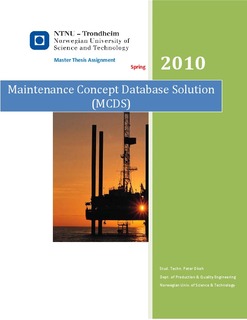| dc.description.abstract | Ineffective maintenance has caused several organizations great economic loss in repairs and lost production in addition to the potential threat to both the health and safety of employees and the environment. The cause of this problem may be from outside the organization or within it. Internally, the problem may be borne from outdated maintenance philosophy, unoptimized maintenance, unclosed maintenance process loop, nonconformance to regulatory requirements, lack of human resources development, lack of motivation, unsafe acts/conditions and poor organizational structure. The possible internal causes of this problem are explained briefly as follows.
Outdated Maintenance Philosophy: an organization that focuses on reactive maintenance (instead of value-added functions) based on their belief that maintenance is a necessary evil or liability is already doomed to be ineffective.
Unoptimized Maintenance: unoptimized maintenance strategy, unoptimized spare parts strategy, unoptimized manpower strategy and unoptimized maintenance intervals (i.e.determining intervals without considering criticality and cost) could lead to wasteful maintenance decisions.
Unclosed Maintenance Process Loop: Missing or ineffective feedback and control loops among the six phases of an ideal maintenance process (work identification, work planning,work scheduling, work execution, history recording and analysis) could lead to ineffective maintenance.
Non-conformance to Statutory/Regulatory Requirements: Non-conformances such as breach of work permit system or insufficient classification of systems/equipment could also result in effective maintenance and may in turn lead to major accidents.
Lack of human resources development: Lack of programs to upgrade the knowledge and skill levels of maintenance staff could lead to obsolescence and impede the philosophy of continuous improvement.
Lack of motivation: Maintenance workers who are demoralized by unfavorable organizational factors may become disoriented and prone to poor attitude to work, errors and accidents.
Unsafe acts and unsafe conditions: Unsafe work procedures and habits and unsafeworkplace could lead to accidents and incidents and in turn ineffective maintenance.
Poor Organizational Structure: Communication gap between the maintenance department and production department could also lead to ineffective maintenance, for example, the production staff may overrun machines, thus increasing maintenance problems or the maintenance team may require data like machine run time from the production team without getting it on time.
There is the need to help maintenance staff do their jobs more efficiently and effectively, by automating the maintenance process, by using failure data analysis to refine maintenance strategies, by cultivating sound inter-departmental relations, by reducing job and workplace hazards, by training and motivating the workforce, and by conducting periodic maintenance management reviews/audits.
AGR Field Operations-Maintenance Engineering (AGR FO ME) seeks to evaluate, in conjunction with NTNU, the possibility of establishing a database of maintenance and integrity data on a micro level and connecting it to analytical tools, through a Master Thesis.
AGR Field Operations (AGR FO) is a leading provider of global services and technologies to the oil and gas industry, delivering services within Inspection & Integrity, Operations & Maintenance, Project Management & Engineering, Subsea services and Alternative Energy.
This thesis will tackle the issue of unoptimized maintenance among all the aforementioned possible maintenance-related problems.
The scope of the thesis is limited to the following:
1. Description and evaluation of existing maintenance database solutions.
2. Evaluation of how criticality based on NORZOK Z-008 and RCM logic can be implemented in a maintenance concept.
3. Suggestion of a way to adapt the concepts according to a client’s requirements (i.eone concept with several versions based on operational profile).
4. Evaluation of the market potential of a database as described above and suggestion of a feasible way to offer it to the market. | nb_NO |
